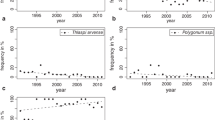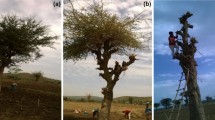Abstract
The effects of spacings between hedgerows (alley widths) and the spacings of trees within hedgerows ofGliricidia sepium on growth and grain yield of maize were investigated at Senehun in southern Sierra Leone. Four between-row spacings (2, 4, 6 and 8 m) were combined with three within-row spacings (0.25, 0.50 and 1.00 m) in a split block design. Maize, at densities of 20,000, 40,000 and 53,333 plants ha−1, was established in the alleys and also as pure crops. N, P and K fertilizers were applied to all plots before pruning of the trees began. When pruning started, only the pure maize plots received fertilizer; prunings from the hedgerows were returned to the appropriate alleys in the other plots.
Plots with the highest maize populations consistently gave the best yields before pruning started, but lower populations gave improved yields after pruning. Yields of maize increased with increasing alley widths before the start of pruning, after which the narrower alleys of 2 and 4 m outyielded the wider ones by almost double, probably because of the large amount of nutrients applied in prunings. Lack of light limited grain yields before the start of pruning, when there was some shading by the hedgerows. Alleys of 2–4 m wide, planted no closer than 0.50 m within rows, resulted in more than twice the yields of maize than in the 8-m alleys planted at 0.25 m within rows, once the hedgerows were well established and were being managed.
Similar content being viewed by others
References
Adaptive Crop Research and Extension Project (ACRE) (1983) Baseline agronomic survey report of Sierra Leone. ACRE Project, MAF/USAID, Sierra Leone
Adams JE (1970) Effect of mulches and bed configurations. II. Soil temperature and growth and yield responses of grain sorghum and corn. Agronomy Journal 62: 785–790
Alferez AC (1980) Utilization ofLeucaena as organic fertilizer to food crops. Second SEARCA Professorial Lecture, December 16, 1980
Bouldin DR, Reid RS and Stangel PJ (1980) Nitrogen as constraint to non-legume food crop production. In: Drosdoff M, Zandstra H and Rockwood WG, eds, Priorities for Alleviating Soil Related Constraints to Food Production in the Tropics, pp 299–316. International Rice Research Institute and Cornell University, Los Banos, Philippines
Escalada RG (1980) Manipulation of cultural practices for ipil-ipil (Leucaena leucocephala) for maximum organic matter production and its effects in intercropped cassava. Terminal Report. PCARR-Funded Research Project, Department of Agronomy and Soil Science, Visaya State College of Agriculture, Baybay, Leyte, Philippines
Evensen CLI (1983) Synopsis ofLeucaena/maize green manuring study. University of Hawaii, Hawaii, USA
Getahun A (1981) IITA/IDRC agroforestry trials. Progress Report. IITA, Ibadan, Nigeria, August, 1981
Gueverra AB (1976) Management ofLeucaena leucocephala for maximum yield and nitrogen contribution to corn in polycrop systems. PhD thesis, Dept Agronomy and Soil Science, University of Hawaii, Hawaii, USA
International Institute of Tropical Agriculture (IITA) (1979) Selected Methods for Soil and Plant Analysis. Manual Series No 1, IITA, Ibadan, Nigeria, 70 pp
IITA (1981) Annual Report for 1980, IITA, Ibadan, Nigeria, 185 pp
IITA (1983) Annual Report for 1982, IITA, Ibadan, Nigeria, 217 pp
Kang BT and Duguma B (1984) Nitrogen Management in alley cropping systems. Proc International Symposium on Nitrogen Management in Farming Systems in the Tropics, 23–26 October, 1984, IITA, Ibadan, Nigeria, 17 pp
Kang BT, Wilson GF and Lawson TL (1984) Alley Cropping: A Stable Alternative to Shifting Cultivation. IITA, Ibadan, Nigeria
Karim AB (1987) Alley cropping in the uplands of Sierra Leone. PhD thesis, University of Oxford, 272 pp
Karim AB and Savill PS (1991) Effect of spacing on growth and biomass production ofGliricidia sepium (Jacq) Walp in an alley cropping system in Sierra Leone. Agroforestry Systems 16: 213–222
Linn CS and Morse PM (1975) A compact design for spacing experiments. Biometrics 31: 661–671
Nyamai DO (1987) Crop production in an intercropping system with tropical leguminous trees. PhD thesis, University of Oxford, UK
Rachie KO (1983) Intercropping tree legumes with annual crops. In: Huxley PA, ed, Plant Research and Agroforestry, pp 101–116. Proceedings of a consultative meeting held in Nairobi, 9–12 April, 1981
Torres F (1983) Potential contribution ofLeucaena hedgerows intercropping with maize to the production of organic nitrogen and fuelwood in the lowland humid tropics. Agroforestry Systems 1: 332–333
Author information
Authors and Affiliations
Rights and permissions
About this article
Cite this article
Karim, A.B., Savill, P.S. & Rhodes, E.R. The effects of between-row (alley widths) and within-row spacings ofGliricidia sepium on alley-cropped maize in Sierra Leone. Agroforest Syst 24, 81–93 (1993). https://doi.org/10.1007/BF00705269
Issue Date:
DOI: https://doi.org/10.1007/BF00705269




